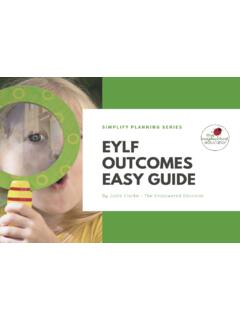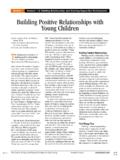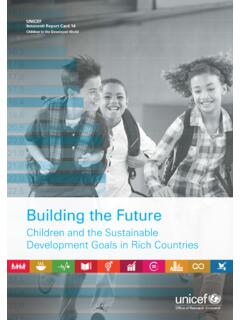Transcription of Children’s need for time and space to play
1 16/1/07 3:13 pm Page 5. 1. < strong >childrenstrong > 's need for time and < strong >spacestrong > to play Environments for play make up part of the landscape of childhood. Awareness of the local context and wider trends which impact on < strong >childrenstrong > 's lives help us to develop spaces that better meet their needs. In this chapter we will look at: < strong >childrenstrong > 's need for time and < strong >spacestrong > to play and specifically drawing on one's own resources identity connection to the community social relations contact with nature physical activity. A spectrum of play types. Building up a picture of play opportunities in your area.
2 There is no doubt that < strong >childrenstrong > 's access to < strong >spacestrong > and time for play has dramatically altered over the latter part of the twentieth century and the beginning of the twenty-first. Many of the concerns that relate to environments for play are indicative of general global trends a loss of < strong >spacestrong > , the encroachment of adult management into < strong >childrenstrong > 's free time, fears about < strong >childrenstrong > 's use of outdoor < strong >spacestrong > (because of traffic, stranger danger', bullying). Many of these changes give rise to serious concerns regarding the development of < strong >childrenstrong > and their immediate and long-term health, wellbeing and happiness.
3 The well-documented 5. 16/1/07 3:13 pm Page 6. ENVIRONMENTS FOR OUTDOOR PLAY. increase in childhood obesity and diabetes is noted not only in Hong Kong but also in the UK, in the USA and in Pacific countries. The negative results of inactivity and confine- ment to indoor spaces will have lifelong implications for those < strong >childrenstrong > . Loss of < strong >spacestrong > for < strong >childrenstrong > 's play can be seen every time a playing field is sold off for devel- opment or when green < strong >spacestrong > is lost to urbanisation. However, it is not just the physical loss of < strong >spacestrong > that impacts on < strong >childrenstrong > .
4 < strong >childrenstrong > are excluded from more and more places for play and not just those (such as railway tracks) that are understandably forbidden. Increasingly rules and regulations bar < strong >childrenstrong > from playing in what were once public spaces (shopping centres and malls replace the public < strong >spacestrong > of market squares and piaz- zas; theme parks replace public parks; school playgrounds fall under the ownership of management companies and are locked out of hours; young people are corralled into skate parks to avoid their public display). Public attitudes often seem to suggest that chil- dren's play is a nuisance or even a criminal act and that a child playing outside without adult supervision is neglected, even if they are in the street around their home.
5 These notions are sanctioned through the use of curfews and orders to disperse groups of young people in certain areas and in some countries. < strong >childrenstrong > 's need for time and < strong >spacestrong > to play The constraints and fears that limit < strong >childrenstrong > 's opportunities for play, particularly out- doors, deprive < strong >childrenstrong > of essential childhood experiences and opportunities . opportunities to develop friendships and negotiate relationships; opportunities to grap- ple with the full gamut of emotions including those such as jealousy, boredom or anger, as well as happiness and satisfaction; opportunities to take risks, have adventures and misadventures; to have contact with nature and the environment.
6 It is because play offers unique benefits to < strong >childrenstrong > that the right to play is included in Article 31 of the UN Convention on the Rights of the Child which recognises: the right of the child to rest and leisure, and to engage in play and recreational activities appropriate to the age of the child and to participate freely in cultural life and the arts. (UNICEF, 1989). Drawing on one's own resources In our hurried world, time for play as well as < strong >spacestrong > to play can be in short supply for chil- dren whose schedules are as full as a chief executive's.
7 Individually, schools, childcare, after school activities and clubs have their own benefits, but do they leave enough time for the child to fall back on their own resources? Are < strong >childrenstrong > still having a chance to be bored, to hang about apparently aimlessly with friends, to be unsupervised? Is there time for a toddler to dawdle along picking up sticks? Or for an eight year old to mess about on the way home from school or for an adolescent to set aside their timetable and hang out with friends or for any of us to take time to assimilate our experiences?
8 If not, then an essential ingredient is missing. 6. 16/1/07 3:13 pm Page 7. < strong >childrenstrong > 'S NEED FOR TIME AND < strong >spacestrong > TO PLAY. Sometimes making < strong >spacestrong > for < strong >childrenstrong > 's play has less to do with the physical develop- ment of a site and more to do with releasing some time back into < strong >childrenstrong > 's control . whether that's re-introducing recess' or playtime' back into the school day, disorganis- ing the programme of a club, or parents taking the decision not to fill a child's week with activity after activity. It is often adults rather than < strong >childrenstrong > who gain most from the planned programme of a club (which can act rather like a security blanket for us).
9 We tend to worry about what would happen should our < strong >childrenstrong > become out of control' and can be somewhat uncer- tain as to what we should be doing if we are not occupying the < strong >childrenstrong > . And yet, replacing < strong >spacestrong > for < strong >childrenstrong > 's own agency with adult agendas largely excludes spontane- ity, imagination, unpredictability, flexibility all the qualities we associate with free play. Creating time for < strong >childrenstrong > 's play allows them the opportunity to draw upon their own resources. Practitioners can support < strong >childrenstrong > 's view of themselves as people with a unique mix of skills, talents, capacities and potential.
10 A full life needs us to respond to difficulties we encounter, to face up to conflicts, be flexible problem solvers, to recognise challenges and opportunities when we see them, to learn from difficult as well as plea- surable experiences and deal with disappointment. These experiences in self-directed play provide < strong >childrenstrong > with vital opportunities in the development of resilience. Identity For < strong >childrenstrong > to develop confidence and their own sense of identity it is essential that they go through these processes themselves these cannot be replaced by adult-managed lessons.
















